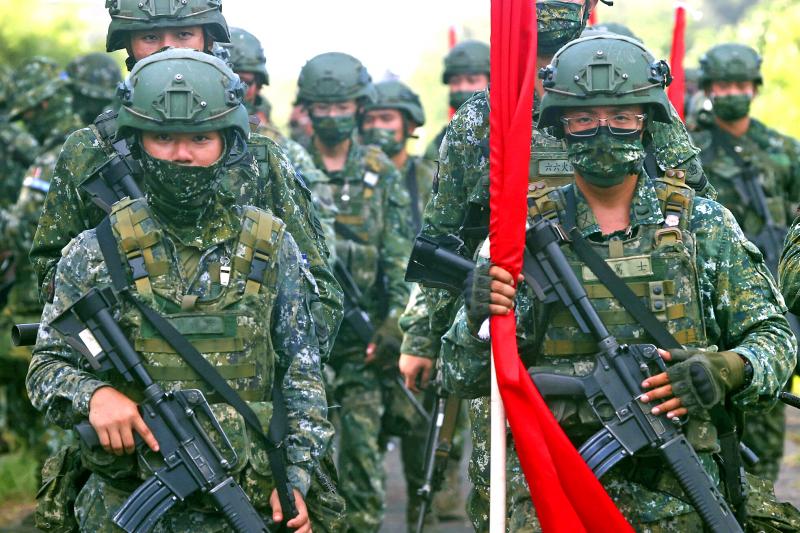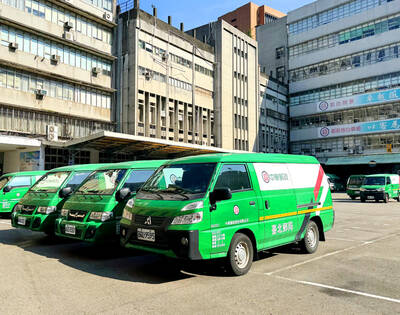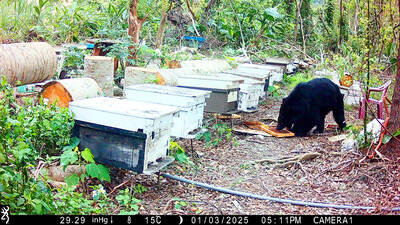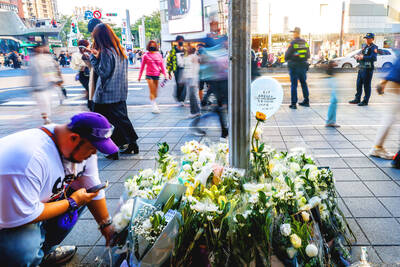Lawmakers are calling for reservist standards to be relaxed to boost their numbers, as well as for improved combat training.
Democratic Progressive Party (DPP) Legislator Wang Ting-yu (王定宇) on Friday said that Taiwan should take lessons Ukraine’s preparedness for invasion.
Kyiv mobilized its reservists at the last minute, demonstrating a lack of systems in place to assemble them in time, Wang said, adding that simply handing out weapons to citizens does not make them adequate as troops.

Photo: Reuters
The majority of Taiwan’s 2.5 million reservists lack training, and the government should improve reservist instruction, he said.
The military’s first-wave reservists, numbered at 300,000, should be fully trained and on standby at all times, he said.
First-wave reservists are those expected to join the standing military force when an enemy launches a first strike against Taiwan.
A nation must have enough reservists to call on if total mobilization is required, DPP Legislator Tsai Shih-ying (蔡適應) said.
He also called for reservist training on a regular rotation and said that the military should consider expanding the reservist pool.
Institute for National Defense and Security Research senior analyst Su Tzu-yun (蘇紫雲) said Taiwan’s current “combat reservists” system only accepts those who retired after volunteering to serve in the military.
Relaxing standards would allow those who previously underwent mandatory service to join, he said, adding that the government should reinstate mandatory service of nine months to one year.
If this proves difficult, four months of service would suffice, provided there is regular recall training, he said.

SHIPS, TRAINS AND AUTOMOBILES: The ministry has announced changes to varied transportation industries taking effect soon, with a number of effects for passengers Beginning next month, the post office is canceling signature upon delivery and written inquiry services for international registered small packets in accordance with the new policy of the Universal Postal Union, the Ministry of Transportation and Communications said yesterday. The new policy does not apply to packets that are to be delivered to China, the ministry said. Senders of international registered small packets would receive a NT$10 rebate on postage if the packets are sent from Jan. 1 to March 31, it added. The ministry said that three other policies are also scheduled to take effect next month. International cruise ship operators

NUMBERS IMBALANCE: More than 4 million Taiwanese have visited China this year, while only about half a million Chinese have visited here Beijing has yet to respond to Taiwan’s requests for negotiation over matters related to the recovery of cross-strait tourism, the Tourism Administration said yesterday. Taiwan’s tourism authority issued the statement after Chinese-language daily the China Times reported yesterday that the government’s policy of banning group tours to China does not stop Taiwanese from visiting the country. As of October, more than 4.2 million had traveled to China this year, exceeding last year. Beijing estimated the number of Taiwanese tourists in China could reach 4.5 million this year. By contrast, only 500,000 Chinese tourists are expected in Taiwan, the report said. The report

The Forestry and Nature Conservation Agency yesterday launched a gift box to market honey “certified by a Formosan black bear” in appreciation of a beekeeper’s amicable interaction with a honey-thieving bear. Beekeeper Chih Ming-chen (池明鎮) in January inspected his bee farm in Hualien County’s Jhuosi Township (卓溪) and found that more than 20 beehives had been destroyed and many hives were eaten, with bear droppings and paw prints near the destroyed hives, the agency said. Chih returned to the farm to move the remaining beehives away that evening when he encountered a Formosan black bear only 20m away, the agency said. The bear

HORROR STORIES: One victim recounted not realizing they had been stabbed and seeing people bleeding, while another recalled breaking down in tears after fleeing A man on Friday died after he tried to fight the knife-wielding suspect who went on a stabbing spree near two of Taipei’s busiest metro stations, Taipei Mayor Chiang Wan-an (蔣萬安) said. The 57-year-old man, identified by his family name, Yu (余), encountered the suspect at Exit M7 of Taipei Main Station and immediately tried to stop him, but was fatally wounded and later died, Chiang said, calling the incident “heartbreaking.” Yu’s family would receive at least NT$5 million (US$158,584) in compensation through the Taipei Rapid Transit Corp’s (TRTC) insurance coverage, he said after convening an emergency security response meeting yesterday morning. National